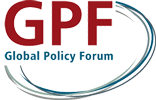News

From October 15-17, it’s time once again for the "who's who" of global health experts to meet in Berlin for the World Health Summit. More than 6,000 participants are expected over three days. But will the right lessons be learned from the experience of the Corona pandemic to build a sustainable global health architecture?
For decades, the global community has struggled with the challenges of a highly fragmented global health architecture. Numerous international organizations, among them the World Bank and UNAIDS, private foundations such as the Bill & Melinda Gates Foundation and the Wellcome Trust, health institutes, pharmaceutical companies, and even multi-stakeholder initiatives like the GAVI Vaccination Alliance and the Global Fund are creating growing confusion. The World Health Organization (WHO) is only one of many actors in this context, although it plays a central role in the coordination of global health policy.
But fragmentation is growing. Each actor has its own interests, sets different priorities, and uses different methods and financing instruments. The consequences, especially for countries in the Global South, are increased transaction costs, more difficult coordination, conflicting or duplicated measures, and areas of responsibility that remain underfunded. In addition, there is competition for funds between the actors and the difficulty of externally monitoring and accompanying all the initiatives with all their own structures – by civil society, but above all, also by WHO and the governments themselves.
The problems associated with the fragmented landscape of actors became particularly clear in the face of the uncoordinated response to the COVID-19 pandemic. WHO's mandates for equitable and efficient distribution of vaccines and other necessary medical supplies to contain the pandemic were not met. WHO, in cooperation with several governments, philanthropic foundations, pharmaceutical industry, and other multi-stakeholder partnerships, established the global multi-stakeholder Access to COVID-19 Tools Accelerator (ACT-A) initiative as the key global mechanism to contain the pandemic. But the consequence was that WHO played only a secondary role within the initiative.
ACT-A subsequently failed not only in its goals for global distribution of vaccines, but also in the initiative's claim to coordination. This was partly because the countries of the Global North were hoarding vaccines on their own, but also because of the fundamental problems inherent in the structure of a multi-stakeholder initiative such as ACT-A. The reason for this is that such initiatives, in which all stakeholders usually have the same decision-making powers, are based on voluntary commitments by participating countries, companies, foundations, and other organizations.
Mulit-Stakeholder Initiatives (MSI) are not a solution to the challenges of a fragmented healthcare landscape. They are part of the problem. Yet instead of learning from past mistakes, particularly ACT-A, various global health actors are once again crafting similar tools to respond to future pandemics – as they did at this year's World Health Summit.
Instead of contributing to further fragmentation of the Global Health Architecture through ever new MSIs based on the principle of voluntarism, governments and companies must be committed to more binding commitments. In concrete terms, from our point of view, this means:
- Under the pandemic treaty, governments should make a binding commitment to globally equitable access to essential medical products and the sharing of data and technologies and know-how, and designate clear responsibilities.
- Governments should not leave it up to companies to decide to whom they sell essential medicines and technologies, how much of them they produce, and whether they share the knowledge to produce them. Especially when public money has been invested, companies should be required to be transparent about the costs of research, development, and production of medicines and technologies, and transparent about pricing.
- In line with the One Health approach, governments should not only strengthen preparedness and response to future health crises, but also commit to their prevention.
- Accountability and transparency of governments and intergovernmental organizations must be increased. Only with a strong enforcement mechanism will the pandemic treaty and other health agreements be effective. The dispute resolution mechanism for violations of the International Health Regulations should be strengthened and made binding on States Parties.
- Including and strengthening the voice of civil society organizations, especially local actors and groups, from the Global South is essential, as it is they who hold governments and influential actors in global health accountable for their (non)actions.
- Finally, the accountability and transparency of MSIs and other influential actors in global health to public bodies must be increased. This requires a comprehensive legal and institutional framework for multi-stakeholder partnerships to ensure that the risks and side effects of partnerships with private actors* described above are avoided.
If these reform proposals are included in the negotiations, this year's World Health Summit in Berlin will be able to send a clear signal to strengthen the Global Health Architecture.
For more background information, see the detailed briefing paper "A pandemic of voluntarism – The Increasing Fragmentation of the Global Health Architecture by Ever New Multi-stakeholder Initiatives" by Karolin Seitz.
